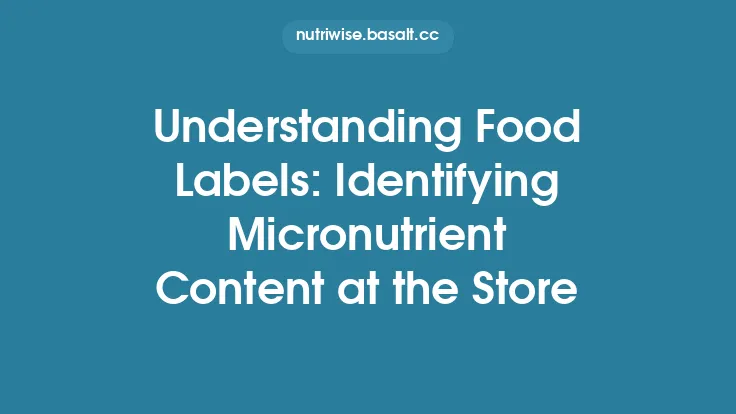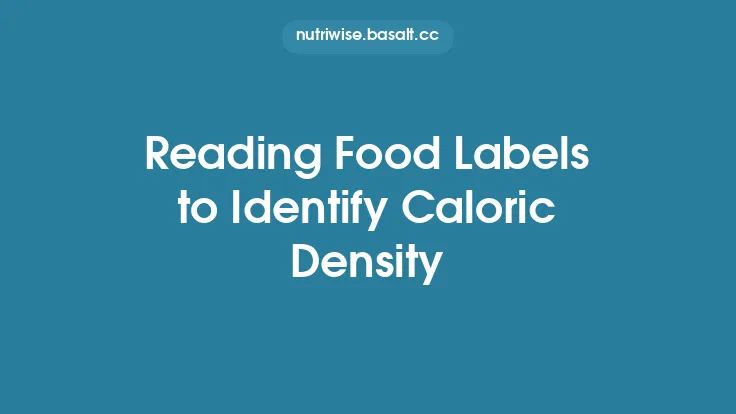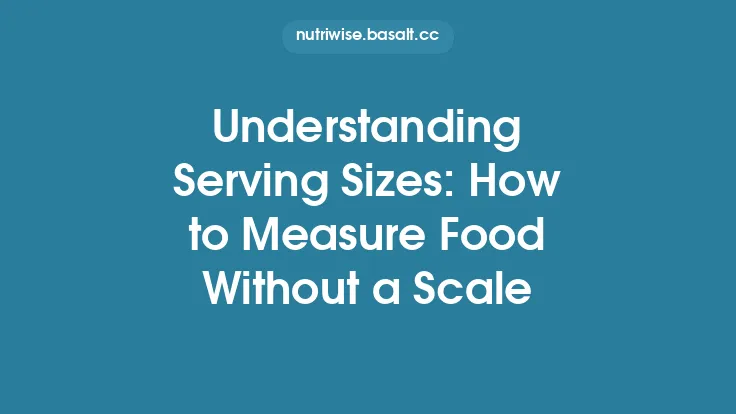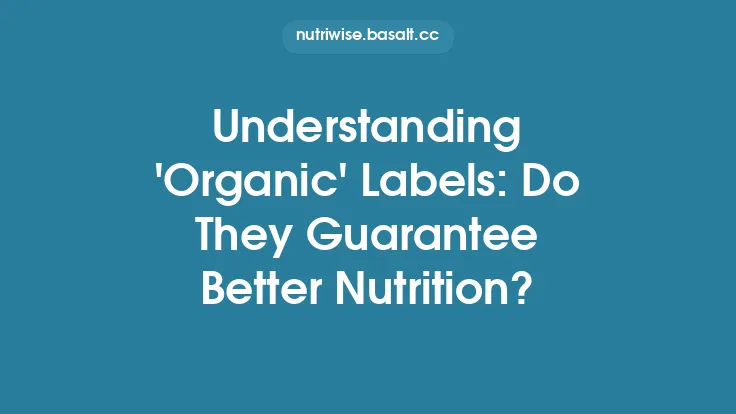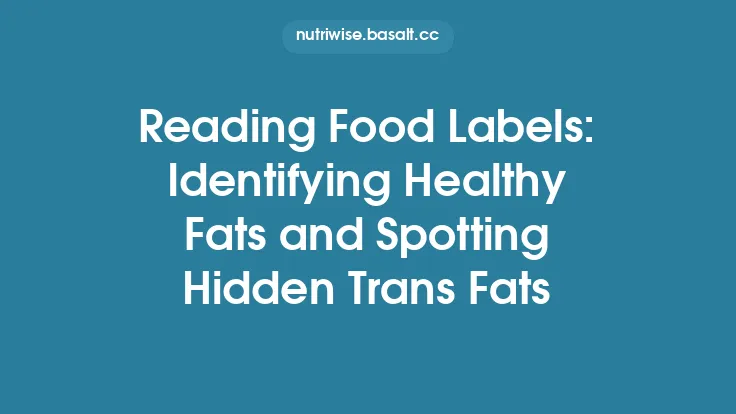Understanding food labels is a cornerstone of savvy, budget‑friendly meal planning. While many shoppers glance at the price tag and move on, the information printed on the package can reveal hidden costs, nutritional pitfalls, and opportunities to stretch every dollar further. By learning how to read, interpret, and apply the data on nutrition facts panels, ingredient lists, and other label elements, you can make choices that not only protect your health but also maximize the value of every purchase.
Why Food Labels Matter for Budget‑Conscious Shoppers
- Transparent Cost Indicators – Labels often disclose the net weight, serving size, and number of servings per container. These figures let you calculate the true cost per serving, a more accurate metric than the shelf price alone.
- Nutrient Density vs. Price – A cheap‑looking product may be high in added sugars, sodium, or low‑quality fats, which can increase long‑term health expenses. Understanding nutrient density helps you avoid “false bargains.”
- Shelf‑Life Clues – “Best if used by,” “sell‑by,” and “use‑by” dates provide insight into how long a product will remain safe and palatable, influencing waste reduction and overall cost.
- Regulatory Guarantees – In many jurisdictions, labeling requirements are legally enforced, meaning the data you see is vetted and reliable for comparison across brands.
Decoding the Nutrition Facts Panel
The Nutrition Facts panel is standardized, but each element carries specific implications for value:
| Element | What It Shows | How It Impacts Value |
|---|---|---|
| Serving Size | The amount the manufacturer considers a single serving (e.g., 1 cup, 30 g). | Compare the listed serving size to the amount you actually consume. If you eat twice the serving, the cost per actual portion is effectively halved. |
| Servings Per Container | Number of servings the package contains. | Multiply the cost per package by the number of servings to get cost per serving. |
| Calories | Energy content per serving. | High‑calorie, low‑nutrient foods may provide cheap energy but poor satiety, leading to higher overall food intake. |
| % Daily Value (%DV) | Percentage of the recommended intake for a nutrient based on a 2,000‑calorie diet. | Values >20 % are considered high; <5 % low. Prioritize foods that give you high %DV for nutrients you need (e.g., iron, calcium) without excess calories. |
| Macronutrients | Total fat, saturated fat, trans fat, cholesterol, sodium, total carbohydrate, dietary fiber, total sugars, added sugars, protein. | Identify “empty calories” (high added sugars, low fiber) that may inflate cost per nutrient. |
| Micronutrients | Vitamin D, calcium, iron, potassium, etc. | Foods that deliver essential micronutrients at low cost can replace expensive supplements. |
Practical tip: Convert the %DV into actual grams or milligrams when you need precise amounts for dietary goals. For example, if the label shows 15 % DV of iron (which is 18 mg for adults), the product provides 2.7 mg of iron per serving.
Understanding Ingredient Lists and Additives
- Order of Ingredients – Ingredients are listed in descending order by weight. The first three items typically dominate the product’s composition.
- *Value Insight*: A product where “water” or “whole grain” appears first is often less processed and may offer more bulk for the price.
- Identifying Fillers and Extenders – Terms like “maltodextrin,” “modified starch,” “hydrolyzed soy protein,” and “cellulose” are often used to increase volume without adding nutritional value.
- *Cost Impact*: These additives can lower the price per weight but may dilute nutrient density, leading you to purchase larger quantities to meet nutritional needs.
- Added Sugars vs. Natural Sweeteners – Look for “sucrose,” “high‑fructose corn syrup,” “dextrose,” or “maltose” as added sugars. Natural sweeteners (e.g., “honey,” “maple syrup”) are still sugars but may be present in smaller amounts.
- *Budget Angle*: Products with high added sugar often have a lower price per gram but can cause spikes in hunger, prompting additional purchases.
- Allergen and GMO Statements – While not directly tied to cost, these disclosures can affect your choice if you need to avoid certain ingredients, potentially steering you toward more affordable alternatives.
- Preservatives and Stabilizers – Common examples include “sodium benzoate,” “potassium sorbate,” “citric acid,” and “xanthan gum.”
- *Shelf‑Life Benefit*: These can extend product longevity, reducing waste, but they may also indicate a highly processed item that could be replaced by fresher, cheaper options when in season.
Unit Pricing and Yield Calculations
1. Cost per Unit of Weight or Volume
- Formula:
\[
\text{Cost per Unit} = \frac{\text{Package Price}}{\text{Net Weight (or Volume)}}
\]
- Example: A 500 g bag of beans costs $2.50 → $2.50 ÷ 0.5 kg = $5.00 per kilogram.
2. Cost per Edible Yield
Some products lose weight during preparation (e.g., meat loses moisture, canned vegetables lose liquid). Adjust for yield:
- Yield Factor = (Edible weight after cooking) ÷ (Raw weight)
- Adjusted Cost per Edible Unit = (Cost per raw unit) ÷ Yield Factor
Illustration:
- Raw chicken breast: $4.00 per 1 kg, typical cooking yield 75 % → Edible weight = 0.75 kg.
- Adjusted cost = $4.00 ÷ 0.75 = $5.33 per edible kilogram.
3. Comparing Pack Sizes
When two packages have different sizes, use the cost per edible unit to decide. A 12‑oz can of tomatoes at $1.20 versus a 28‑oz can at $2.00:
- Cost per ounce (12‑oz) = $0.10
- Cost per ounce (28‑oz) = $0.071
The larger can offers better value, assuming you can use the extra product before it spoils.
Identifying Value‑Driven Claims
Food labels often feature marketing claims that can be misleading if taken at face value. Understanding the regulatory definitions helps you separate genuine value from hype.
| Claim | Regulatory Meaning (U.S. FDA/EFSA) | Value Implication |
|---|---|---|
| “No Added Sugar” | No sugars added during processing; natural sugars may still be present. | May reduce hidden calories, but check total sugars. |
| “Low Sodium” | ≤ 140 mg sodium per serving (U.S.) or ≤ 0.12 g per 100 g (EU). | Useful for health, but verify serving size. |
| “Whole Grain” | At least 51 % whole grain ingredients by weight. | Often higher fiber, but compare cost per gram of whole grain. |
| “Organic” | Certified organic production standards; typically higher price. | May justify cost if you prioritize pesticide‑free produce, but not always a cost‑saving factor. |
| “Gluten‑Free” | Must contain < 20 ppm gluten. | Important for celiac disease; otherwise, may be priced higher without added nutritional benefit. |
| “Reduced Fat” | At least 25 % less fat than the regular version. | Check absolute fat grams; a “reduced” product can still be high in calories. |
Takeaway: Scrutinize the quantitative data (grams, %DV) behind the claim rather than relying solely on the headline.
Spotting Hidden Costs: Sodium, Sugar, and Fats
Even when a product appears inexpensive, excessive sodium, added sugars, or unhealthy fats can create hidden costs:
- Sodium: High‑sodium foods may increase the need for fresh vegetables or low‑sodium seasonings to balance meals, raising overall grocery spend.
- Added Sugars: Sweetened items can cause rapid blood‑glucose spikes, leading to increased hunger and additional snack purchases.
- Saturated & Trans Fats: Foods high in these fats often lack satiety, prompting larger portion sizes.
Label‑Based Strategy:
- Set personal thresholds (e.g., ≤ 200 mg sodium per serving, ≤ 5 g added sugars).
- Use the %DV column to quickly filter out products that exceed your limits.
Using Shelf‑Life Information to Reduce Waste
- “Best if Used By” vs. “Sell‑By”: “Best if used by” relates to quality, not safety. Foods often remain safe beyond this date, allowing you to stretch usage without waste.
- “Use‑By”: Indicates safety; for perishable items, plan consumption within this window.
- “Freeze‑After Opening”: Some products (e.g., fresh herbs, certain dairy) can be frozen to extend life, turning a short‑shelf item into a longer‑term asset.
Cost‑Saving Tip: Purchase items with a later “best if used by” date when on sale, and store them properly (e.g., airtight containers, refrigeration) to maximize usable life.
Leveraging Store Brands and Private Labels
Store brands often meet the same regulatory standards as national brands but at a lower price point. When evaluating:
- Check the Ingredient List – Many store brands use identical ingredients to name‑brand counterparts.
- Compare Nutrition Facts – Ensure the nutrient profile matches or exceeds the national brand.
- Assess Unit Pricing – Store brands frequently have a lower cost per ounce/kilogram.
Example: A store‑brand canned black beans may list “black beans, water, salt” identical to a name brand, yet cost 30 % less per can.
Comparing Pack Sizes and Bulk Options Wisely
Bulk purchasing can be a double‑edged sword. To determine true value:
- Calculate Shelf Life vs. Consumption Rate – If you cannot use a bulk item before it deteriorates, the effective cost per usable unit rises.
- Factor in Storage Costs – Larger quantities may require additional freezer or pantry space, which could translate into indirect expenses (e.g., higher electricity).
- Use “Cost per Meal” Metric – Estimate how many meals a bulk package will provide, then divide the total price by that number.
Scenario: A 5‑lb bag of quinoa costs $8.00. If each meal uses ¼ cup (≈ 43 g) of dry quinoa, the bag yields ~ 52 servings. Cost per meal = $8.00 ÷ 52 ≈ $0.15, a strong value compared to pre‑cooked grain packets at $1.00 per serving.
Tools and Apps for Label Analysis
Modern technology can automate many of the calculations described:
- Barcode Scanners (e.g., MyFitnessPal, Fooducate) – Instantly retrieve nutrition facts, compare cost per serving, and flag high‑sugar or high‑sodium items.
- Unit‑Price Calculators (e.g., “Unit Price” app) – Input price and weight to get cost per ounce/gram.
- Meal‑Cost Planners (e.g., “Paprika” with cost tracking) – Allow you to log ingredient prices and generate per‑recipe cost breakdowns.
These tools help you stay consistent and avoid manual errors, especially when shopping for many items.
Putting It All Together: A Step‑by‑Step Label Evaluation Process
- Read the Net Weight/Volume – Note the total amount of product.
- Identify Servings per Container – Multiply price by servings to get cost per serving.
- Examine the Ingredient List – Ensure the first three ingredients align with your nutritional goals.
- Check the Nutrition Facts – Look for high %DV of nutrients you need and low %DV of added sugars, sodium, and saturated fat.
- Calculate Unit Price – Use weight/volume to find cost per gram or ounce.
- Adjust for Yield – If the product loses weight during cooking, factor in the edible yield.
- Cross‑Reference Claims – Verify marketing statements against the actual numbers.
- Consider Shelf Life – Ensure you can use the product before quality or safety dates expire.
- Compare to Alternatives – Use the same steps for competing brands or pack sizes.
- Make a Decision – Choose the option with the lowest cost per nutrient‑dense serving that fits your storage capacity and consumption timeline.
Common Misconceptions About Labels and Value
| Misconception | Reality |
|---|---|
| “Organic = cheaper” | Organic products often carry a premium; value must be assessed via cost per nutrient, not just price. |
| “Low‑Fat means healthier” | Low‑fat items may compensate with added sugars or refined carbs, eroding nutritional value. |
| “Large packages are always cheaper” | Bulk items can have higher per‑unit costs if they contain more water, air, or non‑edible components. |
| “All calories are equal” | Caloric source matters; 100 kcal from fiber‑rich beans provides more satiety and nutrients than 100 kcal from refined sugar. |
| “Expiration dates are strict safety limits” | “Best if used by” dates are about quality; many foods remain safe beyond that date, allowing you to stretch purchases. |
Understanding these nuances prevents you from making decisions based solely on superficial cues.
By mastering the art of label literacy, you empower yourself to select foods that deliver the most nutrition for the least cost. This systematic approach not only safeguards your wallet but also supports a balanced, health‑conscious diet—key pillars of successful, budget‑friendly meal planning.
